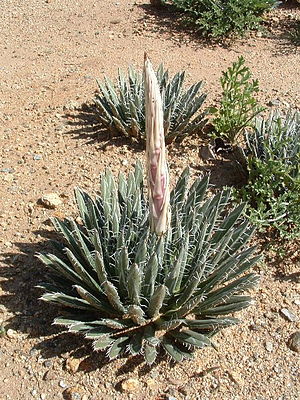Agave polianthiflora
| Agave polianthiflora | ||||||||||||
|---|---|---|---|---|---|---|---|---|---|---|---|---|

Bud agave polianthiflora near Cumbres de Majalca in Chihuahua, Mexico |
||||||||||||
| Systematics | ||||||||||||
|
||||||||||||
| Scientific name | ||||||||||||
| Agave polianthiflora | ||||||||||||
| gentry |
Agave polianthiflora is a plant from the genus of the Agave ( agave ). An English common name is "Gentry's Mescalito Agave".
description
Agave polianthiflora grows individually with a height of 20 to 30 cm or forms small, compact groups with a diameter of up to 50 cm. The linear, lanceolate, stiff, green leaves are 10 to 20 cm long, up to 1.5 cm wide in the middle and have imprints of the bud. The leaf margins are white-fibred and finely serrated at the base. The gray terminal spine becomes 1 cm long.
The spike-shaped, straight inflorescence is 1 to 2 m high. The red colored flowers appear in the upper half of the inflorescence and are 35 to 45 mm long. The funnel-shaped flower tube is 22–32 mm long. The stylus clearly towers over the flower even before the anthesis .
The round to egg-shaped three-chambered capsule fruits are 10 to 15 mm long. The shiny, black seeds are 2.5 to 3 mm long, 3.5 to 4 mm wide and 0.8 mm thick.
The flowering period extends from April to July.
Systematics and distribution
Agave polianthiflora grows in Mexico in the states of Sonora and Chihuahua in rocky areas of the pine and oak forest at an altitude of 1200 to 2000 m. It is associated with succulent and cactus species.
The first description by Gentry was published in 1972.
Agave polianthiflora is a member of the Parviflorae group . It grows in Mexico in limited areas near the Sonora - Chihuahua border and is one of the smallest species in the genus. The precipitation in the region is enormous and amounts to 1000 mm per year. The variably arranged, white-fiber leaf margins are typical. The long-tubular, red-colored flower is unique. It can hardly be distinguished from the Parviflorae members Agave parviflora and subspecies flexiflora , which, however, have the smallest, yellow-colored flowers of the species of the genus. Frosts occur sporadically in the region.
proof
- Howard Scott Gentry: Agave polianthiflora . In: Agaves of Continental North America . The University of Arizona Press, 1982, pp. 203-205.
- Bernd Ullrich: Agave polianthiflora . In: Cacti and other succulents . Volume 40, Issue 12, index card 36, 1989.
- J. Thiede: Agave polianthiflora . In: Urs Eggli (Hrsg.): Succulent lexicon. Monocotyledons . Eugen Ulmer, Stuttgart 2001, ISBN 3-8001-3662-7 , pp. 56 .
- Thomas Heller: Agave polianthiflora . In: agaves . Münster, 2nd edition 2006, pp. 121–122.
Individual evidence
- ↑ In: USDA Agric. Handb. The Agave Family in Sonora . Volume 399, 1972, p. 51.